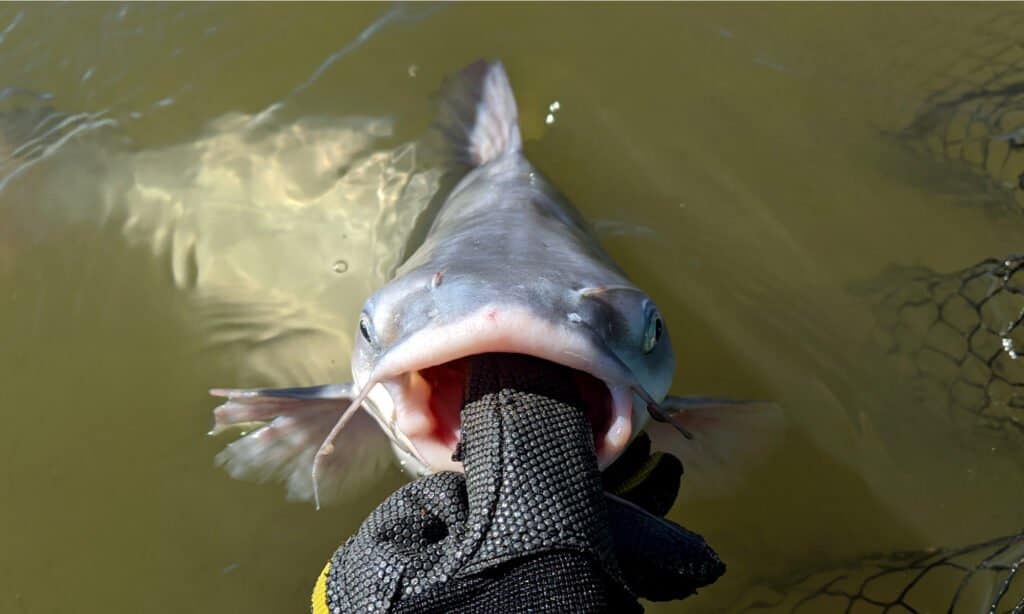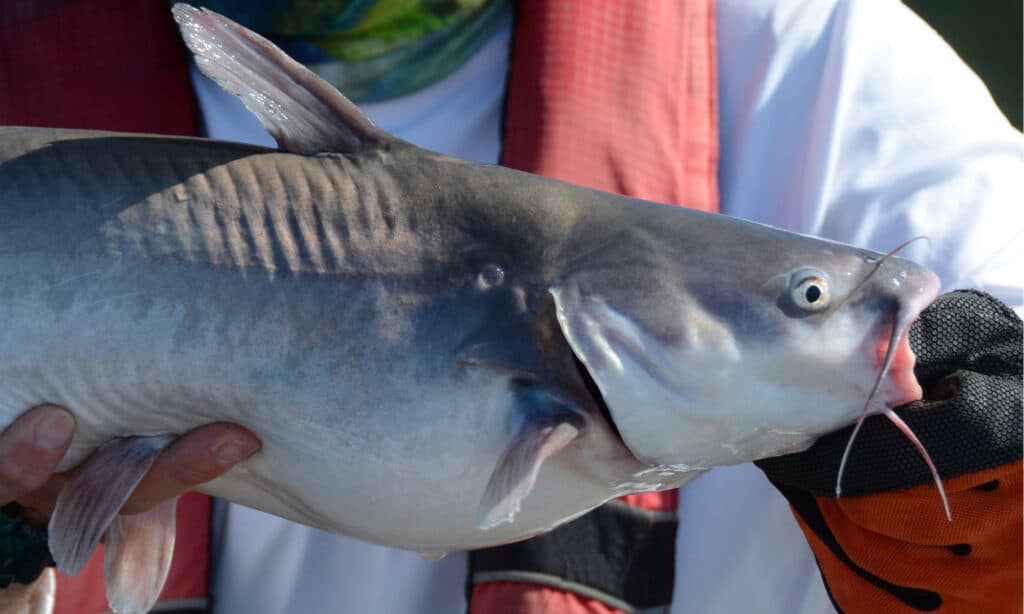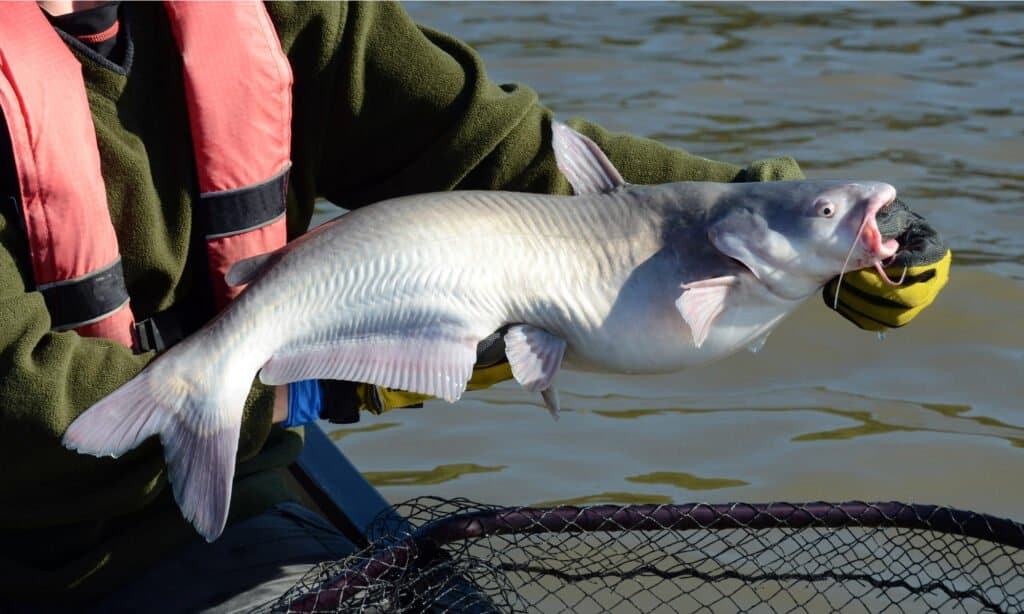Virginia is a state in the southeast United States. It sits between the Atlantic Ocean and the Appalachian mountains. Known as the first English colony of the New World, it has a lot of history, but guess what else it has? A lot of large fish! Read on to discover the largest fish ever caught in Virginia, plus a few more record holders per species.
The Largest Fish Ever Caught In Virginia
The largest fish ever caught in the state of Virginia is a blue catfish. Richard “Nick” Anderson snagged it at Buggs Island Lake, Kerr Reservoir on the border with North Carolina in 2011.
His record-breaking catch was 143 pounds, 57 inches long, and 47 inches in girth.
Anderson’s giant catch broke the International Game Fishing (IGFA) world all-tackle record for blue catfish and was certified on June 22 2011 by the Virginia Department of Game and Inland Fisheries.
The second largest blue catfish ever caught was snagged in February 2012 in Lake Moultrie near Cross, South Carolina. It weighed 136 pounds and was 56 inches long. This fish wasn’t caught with a rod and reel, so it doesn’t hold a state record.
In 2010, Greg Bernal caught the third-largest bluefish on the Missouri River. His catch weighed 130 pounds.
More about blue catfish later, but first, here are some more of Virginia’s record-breaking fish.

©M Huston/Shutterstock.com
Virginia’s Record-Breaking Fish
Pretty big fish and very patient anglers are plentiful in Virginia! Here are a few of the heaviest Virginia state records:
Channel Catfish
Sue Stanley snagged the biggest channel catfish caught in Virginia, in the Rappahannock River in 1992. It weighed 31 pounds and eight ounces.
Common Carp
The largest common carp caught in Virginia weighed 49 pounds 4 ounces, just shy of 50 pounds. Jeff Graham caught it in Lake Prince in June 1986.
Flathead Catfish
Jeffrey E Dill caught the largest flathead catfish in Virginia in Lake Smith, in April 2018. He hauled in the 68-pound 12-ounce monster with a $20 fishing pole from Walmart!
Striped Bass
The largest striped bass ever caught in Virginia weighed in at 53 pounds 7 ounces. James B Davis caught it in Leesville reservoir, in March 2000.
Muskie (including tiger)
Shannon Hill holds the record for the largest muskie caught in Virginia. She snagged the 45-pound 8-ounce whopper in June 2007.
Archery State Record Freshwater Catch
You don’t need a fishing pole to catch massive fish in Virginia. On June 18, 2022, Jason Emmel shot a 66-pound 5-ounce blue catfish on the Pamunkey River in eastern Virginia with a bow and arrow and took the record for a freshwater catch. His huge blue catfish was three feet six inches long and 35 inches in girth.
11 years to the day that Emmel shot his blue catfish, Anderson caught his 143-pound record-breaking blue catfish. There must be something special about Virginia on June 18th for blue catfish!

©Billy Ogle/Flickr – License
All About Blue Catfish
The blue catfish (Ictalurus furcatus) is North America’s largest catfish. They can live for 20 years taking refuge in river bottoms and eating almost anything they can hunt down.
Blue catfish inhabit coastal and inland waters. They are native to Mississippi, Ohio, Rio Grande, and Missouri river basins, but were introduced as sport fish to 20 other areas during the 1970s. From there, blue catfish naturally colonized new tributary rivers because they can cope with brackish water.
Anglers once thought they were freshwater fish, but blue catfish have adapted and swum into adjoining brackish rivers, spreading their range into almost the whole of Chesapeake Bay and beyond.
Officials believe they are a problem there because blue catfish are huge, top-of-the-food-chain predator fish that eat native species including blue crab, shad, herring, Atlantic sturgeon, and striped bass.
Blue catfishes’ voracious appetite for native species may disrupt Virginia’s ecosystems. Therefore, they are invasive in the Chesapeake Bay area.
If you catch one, officials want you to keep it, but luckily they are excellent eating fish fried up with lemon and a side of fries.
Appearance
Blue catfish are brown to slate blue with a white belly and smooth skin. They have deeply forked tails, flat dorsal fins, and eight white barbel whiskers hanging from their mouths. These feline-like whiskers inspired the name “cat” fish.
Catfish whiskers help them taste and smell out their prey, and interestingly their entire bodies are covered in taste buds! This quirk of evolution enables them to hunt out muddy prey from lake bottoms with low visibility.
Adult catfish are large, they are among some of the largest fish frequently caught in Virginia. They can reach five feet long and weigh 100 pounds, although two feet long is most regular.
Diet
Blue catfish eat the majority of fish species. They are opportunistic predators that grab fish, crawfish, mussels, plants, insects, and frogs, taking live prey and scavenging beneath schooling striped bass. They are the only Mississippi river basin dwellers that eat invasive Asian carp adults.
In Chesapeake bay’s tributaries, blue catfish are apex predators and they have very few predators other than birds of prey such as bald eagles (and patient anglers!). It’s no wonder the largest fish ever caught in Virginia is a blue catfish.
Habitat
Blue catfish live in medium to large main river channels and backwaters over swift channels of mud, gravel, and sand. All species of catfish keep cool and safe in river bottom mud.
They prefer fresh water but have no problem coping with brackish water which has allowed them to extend their range.
Spawning
Blue catfish are invasive in Virginia and their high reproductive cycle causes problems. They spawn in late May to June. Each female lays 4,000-8,000 eggs in small tributary rivers, burrowing in mud to hide her eggs from predators. Other fish species eat orange catfish eggs because they are full of fat and protein. They are considered fine caviar by some!

©M Huston/Shutterstock.com
Are They Invasive In America?
Yes, as we’ve seen blue catfish are considered invasive in the Chesapeake Bay. They were introduced in the 1970s in the mistaken belief they would stay in a few rivers on Virginia’s western shores, however, this wasn’t the case. Blue catfish are highly successful predators because they eat such a wide variety of food and have few predators. Electrofishing reveals they are a dominant species in many of Virginia’s tidal rivers.
Are Blue Catfish Venomous?
Blue catfish are mildly venomous, but it’s not enough to kill a human. They have dorsal fin spines and pectoral fins on the head. Sometimes these spines puncture anglers’ hands. It’s not deadly, but a wound might sting a little.
If you are ever “finned” by a catfish, wash the puncture wound thoroughly with soap and water, apply antiseptic cream, and keep an eye on it because some wounds get infected, particularly if a piece of the spine or fin breaks off and lodges under the skin like a splinter.
Difference Between Blue Catfish and Regular Catfish
It’s easy to mistake a blue catfish for other catfish species. Here are the main differences:
- Color: blue catfish are distinctive slate blue.
- Rays: Blue catfish have 30-36 rays on their anal fin, whereas other catfish species have substantially fewer such as a channel catfish that only has 19-30.
- Anal fin: Blue catfish have much longer anal fins that are straighter and deeper than other catfish species.

©M Huston/Shutterstock.com
Virginia’s Largest Ever Caught Fish: Recap
The largest fish ever caught in Virginia is a blue catfish weighing 143 pounds. Richard Anderson hooked it in Buggs Island Lake, Kerr Reservoir.
Anderson landed his world record breaker in 2011. It was 57 inches (144 cm) long and 47 inches (119 cm) in girth putting it towards the upper end of a blue catfish’s age span of 20 years.
The post Discover The Largest Fish Ever Caught in Virginia appeared first on AZ Animals.
from Animal News, Facts, Rankings, and More! - AZ Animals https://ift.tt/GNRX0qH